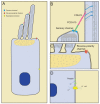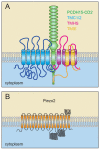Mechanically Gated Ion Channels in Mammalian Hair Cells
- PMID: 29755320
- PMCID: PMC5932396
- DOI: 10.3389/fncel.2018.00100
Mechanically Gated Ion Channels in Mammalian Hair Cells
Abstract
Hair cells in the inner ear convert mechanical stimuli provided by sound waves and head movements into electrical signal. Several mechanically evoked ionic currents with different properties have been recorded in hair cells. The search for the proteins that form the underlying ion channels is still in progress. The mechanoelectrical transduction (MET) channel near the tips of stereociliary in hair cells, which is responsible for sensory transduction, has been studied most extensively. Several components of the sensory mechanotransduction machinery in stereocilia have been identified, including the multi-transmembrane proteins tetraspan membrane protein in hair cell stereocilia (TMHS)/LHFPL5, transmembrane inner ear (TMIE) and transmembrane channel-like proteins 1 and 2 (TMC1/2). However, there remains considerable uncertainty regarding the molecules that form the channel pore. In addition to the sensory MET channel, hair cells express the mechanically gated ion channel PIEZO2, which is localized near the base of stereocilia and not essential for sensory transduction. The function of PIEZO2 in hair cells is not entirely clear but it might have a role in damage sensing and repair processes. Additional stretch-activated channels of unknown molecular identity and function have been found to localize at the basolateral membrane of hair cells. Here, we review current knowledge regarding the different mechanically gated ion channels in hair cells and discuss open questions concerning their molecular composition and function.
Keywords: LHFPL5; PIEZO2; TMC1; TMIE; auditory; hair cell; inner ear; mechanotransduction.
Figures



Similar articles
-
The conductance and organization of the TMC1-containing mechanotransducer channel complex in auditory hair cells.Proc Natl Acad Sci U S A. 2022 Oct 11;119(41):e2210849119. doi: 10.1073/pnas.2210849119. Epub 2022 Oct 3. Proc Natl Acad Sci U S A. 2022. PMID: 36191207 Free PMC article.
-
Subunit determination of the conductance of hair-cell mechanotransducer channels.Proc Natl Acad Sci U S A. 2015 Feb 3;112(5):1589-94. doi: 10.1073/pnas.1420906112. Epub 2014 Dec 30. Proc Natl Acad Sci U S A. 2015. PMID: 25550511 Free PMC article.
-
Disruption of tmc1/2a/2b Genes in Zebrafish Reveals Subunit Requirements in Subtypes of Inner Ear Hair Cells.J Neurosci. 2020 Jun 3;40(23):4457-4468. doi: 10.1523/JNEUROSCI.0163-20.2020. Epub 2020 May 5. J Neurosci. 2020. PMID: 32371604 Free PMC article.
-
Is TMC1 the Hair Cell Mechanotransducer Channel?Biophys J. 2016 Jul 12;111(1):3-9. doi: 10.1016/j.bpj.2016.05.032. Biophys J. 2016. PMID: 27410728 Free PMC article. Review.
-
Function and Dysfunction of TMC Channels in Inner Ear Hair Cells.Cold Spring Harb Perspect Med. 2019 Oct 1;9(10):a033506. doi: 10.1101/cshperspect.a033506. Cold Spring Harb Perspect Med. 2019. PMID: 30291150 Free PMC article. Review.
Cited by
-
Ion modulatory treatments toward functional self-assembled neocartilage.Acta Biomater. 2022 Nov;153:85-96. doi: 10.1016/j.actbio.2022.09.022. Epub 2022 Sep 14. Acta Biomater. 2022. PMID: 36113725 Free PMC article.
-
Recent advancements in understanding the role of epigenetics in the auditory system.Gene. 2020 Nov 30;761:144996. doi: 10.1016/j.gene.2020.144996. Epub 2020 Jul 29. Gene. 2020. PMID: 32738421 Free PMC article. Review.
-
De novo and inherited loss-of-function variants of ATP2B2 are associated with rapidly progressive hearing impairment.Hum Genet. 2019 Jan;138(1):61-72. doi: 10.1007/s00439-018-1965-1. Epub 2018 Dec 8. Hum Genet. 2019. PMID: 30535804 Free PMC article.
-
OSCA/TMEM63 are an Evolutionarily Conserved Family of Mechanically Activated Ion Channels.Elife. 2018 Nov 1;7:e41844. doi: 10.7554/eLife.41844. Elife. 2018. PMID: 30382938 Free PMC article.
-
DNA Methylation Signature in Mononuclear Cells and Proinflammatory Cytokines May Define Molecular Subtypes in Sporadic Meniere Disease.Biomedicines. 2021 Oct 25;9(11):1530. doi: 10.3390/biomedicines9111530. Biomedicines. 2021. PMID: 34829759 Free PMC article.
References
Publication types
Grants and funding
LinkOut - more resources
Full Text Sources
Other Literature Sources
Miscellaneous

